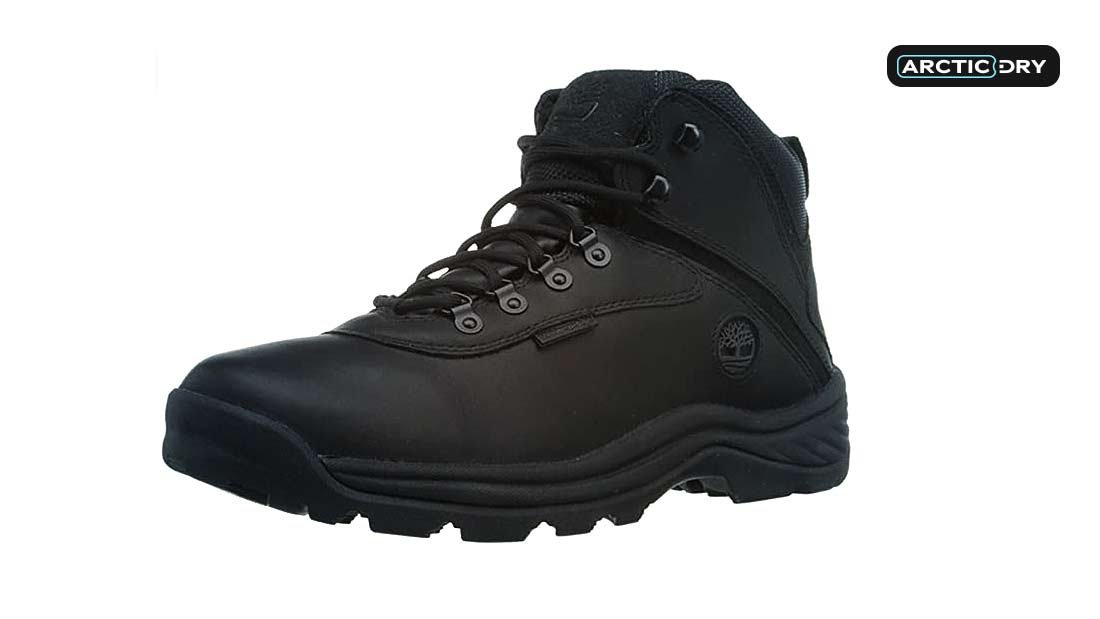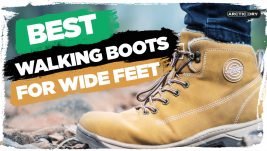The Best Walking Boots for Plantar Fasciitis

Contents
If you are struggling with Plantar Fasciitis, going on a hiking adventure is a thought that might have never crossed your mind. However, you shouldn’t feel limited by your condition, it is still possible to pursue your passion for exploring the great outdoors without aggravating the pain.
The one thing you do need is a good pair of hiking boots that will accommodate for the condition and ease your discomfort.
This is an issue that should be taken extra seriously if you’re keen on hitting the trails, as it could make or break your experience altogether. Luckily, there are multiple brands in the market with hiking shoes dedicated to people with this condition.
These are meant to protect your underfoot and heels from the pain, and ensure that you remain comfortable in the tricky hiking conditions.
In this article, we are reviewing the best boots for hiking available at the moment for plantar fasciitis.
What is Plantar Fasciitis?

Plantar Fasciitis is a common form of heel pain that is prevalent amongst middle-aged women and men, as well as in younger individuals who spend the better part of the day standing.
A good example is athletes or soldiers. People suffering from the condition experience biting and persistent pain at the heel and the underside of the foot.
In most cases, the condition comes about when you strain your Plantar Fascia-a flat ligament connecting your toes and heel bone.
Fortunately, there are various ways of managing the situation and keeping it from getting worse.
One of them is to wear a pair of comfortable shoes with a build that eases the strain on the Plantar Fascia.
This means if you decide to go on a physically intensive activity like hiking while suffering from the condition, care should be taken to find a pair of shoes specifically designed for people like yourself!
Why are Special Hiking Boots for Plantar Fasciitis Necessary?
 Hiking is a popular activity the world over! It is common to find people on the trails over the weekends and during their free time. There are numerous health benefits of hiking, both physical and mental, to be realised from taking a break from your daily routine and going on an expedition of discovery in the great outdoors.
Hiking is a popular activity the world over! It is common to find people on the trails over the weekends and during their free time. There are numerous health benefits of hiking, both physical and mental, to be realised from taking a break from your daily routine and going on an expedition of discovery in the great outdoors.
It’s a hobby that can be physically demanding for “normal people”, let alone those suffering from a foot condition.
This is to say that for persons living with Plantar Fasciitis, hitting the trails is not only a Herculean task but may also end up aggravating the condition.
But hiking is feasible when wearing the right set of walking boots for the condition. That is why the market offers well-designed shoes to help manage the pain so that people living with Plantar Fasciitis can partake in this beneficial outdoor activity.
What Type of Shoes are Suited for Plantar Fasciitis?
The appropriate type of hiking boots for someone with this condition should help to ease the pain while walking and reduce the pressure acting on the ligaments of the underfoot.
Essentially, the shoes should slightly curve at the toe area but not bend at the centre of the outsole. The aim here is to have a shoe with a rigid outsole that won’t strain the Plantar Fascia by bending upwards when you step on the ground.
But the rigidity should not be limited to the sole; ideally, the whole shoe needs to be rigid. This means when you go searching for a shoe, try to feel it in your hands and try to twist the sole and nose.
The right shoe should not twist or bend a great deal. This is a common characteristic of hiking boots, so it shouldn’t be too much of a task finding the type you need for your upcoming adventure.
Should I Go Hiking with Plantar Fasciitis?
Absolutely, but you need to gauge this decision based on your level of pain and discomfort.
Firstly, you have to realise that you’ll only be compounding your pain if you hike a tough trail, so the rest will have to be longer once you’re done with the hike
If you want to support your arches need to get as much support as possible if you have Plantar Fasciitis. During hiking, try to lower your foot closer to the heel to reduce the strain on the ligaments.
Again, this may not be healthy for your condition, but it will be enough to get you through the adventure. Also, try to minimize any weight you are carrying, as well as the distance you’re covering on foot. More importantly, note that these are not long-term solutions, so don’t turn an isolated hike into a habit!
Best Hiking Boots for Plantar Fasciitis – Reviews

Salomon Speedcross 3 Trail Running Shoe

The Salomon Speedcross 3 has been around the hiking circles for a while now but its performance on the trail has never wavered. Thanks to constant updates, this boot has managed to provide improved features for the comfort of the user.
Firstly, they are very lightweight hiking boots and won’t drag you down with fatigue on long hikes. It is quite a choice popular choice for different kinds of adventurers due to its high performance.
Even though you don’t get a rock plate underfoot on the Speedcross 3, this is compensated with substantial cushioning inside to provide decent shock absorption.
The heel is generously cushioned, which should be good news to those who suffer with Plantar Fasciitis, and a great choice for tackling tough hiking trails.
You won’t be disappointed by the traction offered by this shoe either. Its outsole features huge arrow-shaped lugs to offer maximum grip on all kinds of surfaces. The Contragrip rubber helps to reinforce its performance on slippery ground, keeping you on your twos at all times.
With this pair of walking boots, you’ll have no reservations venturing into snowy or muddy trails given how superbly they perform. People with narrow feet will like the fit of the Speedcross 3, but those with wide feet will find them a little uncomfortable.
Overall, the shoe is lightweight, warm, and features a cushy midsole. Its durable leather upper helps to keep small debris at bay, helping to deliver an all-round pair in all kinds of hiking situations.
With all these high-performance features, it’s easy to see why the Speedcross 3s are one of the top hiking boots for Plantar Fasciitis out there!
Merrell Moab Waterproof Hiking Shoe

As its name suggests, the Merrell Moab is a waterproof hiking boot that ensures your feet remain dry and comfortable when hiking in a light shower or plowing through inches of snow.
It features a 100% leather construction that delivers durable performance down the line. This is lined with Gore-Tex material that only offers waterproofing capabilities but also enhances the breathability of the Moab.
A convenient design allows for the free circulation of air into the boot when hiking in hot conditions to reduce discomfort.
You’ll also appreciate the antimicrobial treatment on the inner, which is not a common feature on many hiking boots out there. It protects your feet from harmful bacteria, helping to keep bad odour at bay when you finally take off your boots after a distant hike.
Furthermore, integrated M-select Dry technology helps to shed any moisture that comes into contact with the outer shell. This means if you are walking through wet grass, the technology allows your shoes to dry out faster than usual.
The stable outsole provides exceptional traction when walking on dry rock and gravel. You also get a wide forefoot that offers plenty of room for your toes, as well as a stable platform to step on.
The Moabs are available in both regular and wide sizes, so you find the right fit for your foot size.
Their lacing system is user-friendly and saves you time when wearing the shoe, in addition to enhancing the fit. Overall, you’ll be impressed by the excellent stability these walking boots offer, and the perfect hiking partner they prove to be!
Timberland Men’s White Ledge Waterproof Boot

The White Ledge waterproof hiking boots from Timberland come with a stable design suited for people with a foot condition. An EVA footbed offers great cushioning on the trail and reduces the impact when you step on hard surfaces.
This reduces the strain on your underfoot, ensuring that you remain comfortable throughout the trek. It features a padded collar design that feels cozy against your foot and provides optimal support for enhanced support.
The White Ledge is made out of high-quality leather, which makes up the better part of the outer shell. It delivers a rigorous performance on different walking terrains that will last you a couple of years.
The boot is also waterproof to ensure that you won’t be interrupted by a light shower in the middle of your adventure. Its seam-sealed construction serves to keep your feet dry and warm, as well as prevent the formation of blisters.
The sole is made out of a rubber material that is not only rigid but also bouncy to add a spring to your step. Deep lugs help to enhance your grip on the ground on slippery climbs and unstable descents.
Because of this, you enjoy the flexibility of venturing into different terrains without losing stability. Overall, these trail-ready boots can be called into action anytime you decide to go hiking with a guarantee of top performance.
Merrell Moab 2 Vent Hiking Shoe

If comfort and speed are what you’re after in a hiking boot, then look no further than the Merrell Moab Ventilators. These come in both male and female versions, and the good thing is that both share great features, including ample support, plenty of padding, and reliable traction.
From its name, you can pick that this shoe offers generous ventilation for maximum breathability.
Its air-cushioned midsole, as well as the Vibram multi-sport outsole, deliver needed foot support and traction respectively.
The vent-generous design of the Moabs allows you to hike in hot trails without drenching your feet in sweat. Meanwhile, it will shake off any moisture you pick on the way and dry out faster than other models.
The traction is excellent on various tricky terrains, including gravel and dry rock while a wide forefoot provides a stable platform.
As far as your comfort is concerned, you’ll like the fact that the shoe comes in both regular and wide sizes. This should assure that there a perfect fit for you somewhere. It is also pretty lightweight if don’t like being dragged down by weight and this combines well with the elegant lacing system to eliminate any form of discomfort during your hike.
Another noteworthy feature is the stability of the shoe. Thanks to a wide forefoot, you’ll be reassured in every step that you take knowing that your foot is generously supported. The shoe will perform its performance both in tricky, rough trails, as well in light, well-maintained paths.
This gives you the luxury of choosing a trail of your choice with nothing to slow you down. The tongue is also padded to offer convenient cushioning against the pressure that tight laces can exert. Lastly, its anatomically shaped footbed enhances your level of comfort on multiday hikes.
KEEN Targhee II Hiking Shoe

When it comes to comfort, the Targhee II is one of the most highly rated walking boots for Plantar Fasciitis. This shoe will better suit hikers with wider feet and comes with a sturdy design for excellent performance during hikes.
A shank is included on the Targhees to enhance your stability, allowing you to go for miles without feeling fatigued.
Meanwhile, you get a dual-density EVA midsole that comes in handy when hiking on a dry and hard surface, helping to reduce the impact on your ailing foot.
The huge rubber toe rand on the midsole combines with the EVA to guarantee your foot protection at all times. A Nubuck leather upper keeps any small stones, pebbles, and other debris from getting inside the shoe while a breathable mesh around it makes for the free circulation of air into and out of the shoe.
This proves instrumental in keeping your feet fresh and cool when the trail gets hot. You also get a thick ankle cuff that holds your ankle in place to prevent sprains on steep ascends.
The lacing system is also designed to make the shoe versatile. It enhances the fit of the Targhee IIs, allowing you to remain firm even on uneven surfaces. While it was primarily designed for people with wide feet, you can still snugly fit your narrow foot in some updated versions of the shoe.
Alternatively, you can always go one size down to find the perfect fit for you or get a thick pair of socks to fill up the extra space. Whichever you do, you will be impressed with what these shoes have to offer!
Salomon XA Pro 3D Trail Running Shoe

The Salomon XA Pro 3D Trail Running Shoe is a very good trail running shoe for flat feet that encompasses some very good features such as a cushioned heel as well as an ortholite sock liner which provides high levels of comfort while out on the trail.
When it comes to Plantar Fasciitis having a robust midsole is very important, and luckily with this shoe from Salomon it comes with dual-density EVA foam which provides ample cushioning and support while you’re out hiking.
Upper
Equally, the upper part of your hiking shoe is just as important as the midsole, and this offering from Salomon utilises their Sensifit technology to provide the ultimate fit which cradles your foot.
Outsole
The outsole on this product features the same Contragrip rubber that alot of the Salomon Hiking Boots utilise, which provides superior grip & traction while you’re out on the trail.
Columbia Women’s Newton Ridge Plus Hiking Boot
For the ladies who like to explore the outdoors and hit the trails when the opportunity presents itself, this cute walking boot from Columbia ensures that you don’t leave your sense of style at home.
The Newton Ridge Plus comes with a conveniently feminine design with contrasting color combinations to go with a smooth mesh interior. But aside from making you look good on the trail; they also do a great job of protecting your feet against any kind of damage.
Boasting a waterproof construction, these boots keep your feet dry and warm when you walk through dew-filled grass on those early-morning hikes. Also, you won’t be slowed down by any streams you have to cross or unexpected showers in the middle of your adventure. Its durable mesh tongue helps to keep the boot breathable, ensuring that you don’t feel uncomfortable when the temperatures rise.
The multi-terrain traction system on the rubber sole will come in handy when the surface gets slippery and unstable. A deep lug tread pattern grips the ground firmly, keeping you upright when everyone around you seems to be going down. You’ll also enjoy the plush cushioning on the inner sole, which serves to absorb shock on rough trails and maintain your comfort at all times. The fit is also great and this is enhanced by the lace-up system.
Conclusion
No matter how much you love to go hiking, you shouldn’t let your passion get in the way of Plantar Fasciitis. Nonetheless, you can still enjoy hitting the trails every once in a while and simultaneously manage the situation for your wellbeing.
All you need is the right kind of footwear like the ones we’ve covered in this article. However, you’ll still want to keep your hikes short and shed off any weight you’re carrying to be safer rather than sorry.
Enjoy your hiking!
FAQ
Is it Bad to Walk Barefoot with Plantar Fasciitis?
Generally, it will depend on how serious your condition is. If your Plantar Fasciitis has become so serious that you can barely put on a shoe, leave alone stepping on the ground, then common sense should tell you that trying to walk will only worsen the situation.
This may also lengthen the healing process as it only serves to strain your muscles. As such, you might have to stay bedridden for a little longer.
However, if you’re just starting to feel the pain in your foot, then you may be able to do some walking. This will help to activate your muscles and keep the condition from relapsing. However, you shouldn’t strain yourself while at it. If it gets too painful, there is no shame in taking a rest!
Does Walking Make Plantar Fasciitis Worse?
Yes and No! This is because if your condition has reached a chronic level, then you’ll also be compounding your troubles. Walking adds extra strain to your foot ligaments and causes more pain.
This also means that you’ll need more time to heal, On the other hand, walking can be therapeutic for your Plantar Fasciitis if it’s still in its early stages and far along into your recovery process.
Remember that your foot muscles need to be exercised if they are to feel any better. The constant stretching and relaxation of your muscles help to keep them active as needed. If you decide to venture outside, be sure to get the appropriate pair of shoes to avoid straining your feet.
How Long Should I Hike with My Plantar Fasciitis?
Plantar Fasciitis may not be as complex as some people make it sound. However, recovering from the syndrome will need some decent rest time. Typically, the period needed to heal may range anywhere from 6 weeks to 18 months, depending on the extent of your condition and what you do to manage it.
While one of the goals is to avoid walking, you don’t have to stay bedridden for the whole time you’ll be sick. This could in itself, bring a host of other unwanted conditions.
Occasionally taking a stroll around the house or neighborhood may not hurt, but venturing outside for a hike will not be a good idea.
Nonetheless, it may be beneficial for your mental health and if you have to do it, we recommend you get the right pair of hiking boots to avoid aggravating your Plantar Fasciitis. At the end of the day, you want to consider what you feel when you try to hike to know whether it’s helping or not!








